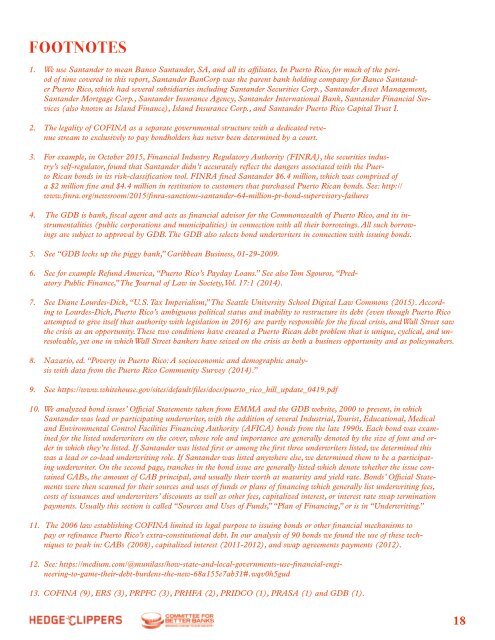PIRATES OF THE CARIBBEAN
20161025_HedgeClippers_ReportPR_v3-3
20161025_HedgeClippers_ReportPR_v3-3
You also want an ePaper? Increase the reach of your titles
YUMPU automatically turns print PDFs into web optimized ePapers that Google loves.
FOOTNOTES<br />
1. We use Santander to mean Banco Santander, SA, and all its affiliates. In Puerto Rico, for much of the period<br />
of time covered in this report, Santander BanCorp was the parent bank holding company for Banco Santander<br />
Puerto Rico, which had several subsidiaries including Santander Securities Corp., Santander Asset Management,<br />
Santander Mortgage Corp., Santander Insurance Agency, Santander International Bank, Santander Financial Services<br />
(also known as Island Finance), Island Insurance Corp., and Santander Puerto Rico Capital Trust I.<br />
2. The legality of C<strong>OF</strong>INA as a separate governmental structure with a dedicated revenue<br />
stream to exclusively to pay bondholders has never been determined by a court.<br />
3. For example, in October 2015, Financial Industry Regulatory Authority (FINRA), the securities industry’s<br />
self-regulator, found that Santander didn’t accurately reflect the dangers associated with the Puerto<br />
Rican bonds in its risk-classification tool. FINRA fined Santander $6.4 million, which was comprised of<br />
a $2 million fine and $4.4 million in restitution to customers that purchased Puerto Rican bonds. See: http://<br />
www.finra.org/newsroom/2015/finra-sanctions-santander-64-million-pr-bond-supervisory-failures<br />
4. The GDB is bank, fiscal agent and acts as financial advisor for the Commonwealth of Puerto Rico, and its instrumentalities<br />
(public corporations and municipalities) in connection with all their borrowings. All such borrowings<br />
are subject to approval by GDB. The GDB also selects bond underwriters in connection with issuing bonds.<br />
5. See “GDB locks up the piggy bank,” Caribbean Business, 01-29-2009.<br />
6. See for example Refund America, “Puerto Rico’s Payday Loans.” See also Tom Sgouros, “Predatory<br />
Public Finance,” The Journal of Law in Society, Vol. 17:1 (2014).<br />
7. See Diane Lourdes-Dick, “U.S. Tax Imperialism,” The Seattle University School Digital Law Commons (2015). According<br />
to Lourdes-Dick, Puerto Rico’s ambiguous political status and inability to restructure its debt (even though Puerto Rico<br />
attempted to give itself that authority with legislation in 2016) are partly responsible for the fiscal crisis, and Wall Street saw<br />
the crisis as an opportunity. These two conditions have created a Puerto Rican debt problem that is unique, cyclical, and unresolvable,<br />
yet one in which Wall Street bankers have seized on the crisis as both a business opportunity and as policymakers.<br />
8. Nazario, ed. “Poverty in Puerto Rico: A socioeconomic and demographic analysis<br />
with data from the Puerto Rico Community Survey (2014).”<br />
9. See https://www.whitehouse.gov/sites/default/files/docs/puerto_rico_hill_update_0419.pdf<br />
10. We analyzed bond issues’ Official Statements taken from EMMA and the GDB website, 2000 to present, in which<br />
Santander was lead or participating underwriter, with the addition of several Industrial, Tourist, Educational, Medical<br />
and Environmental Control Facilities Financing Authority (AFICA) bonds from the late 1990s. Each bond was examined<br />
for the listed underwriters on the cover, whose role and importance are generally denoted by the size of font and order<br />
in which they’re listed. If Santander was listed first or among the first three underwriters listed, we determined this<br />
was a lead or co-lead underwriting role. If Santander was listed anywhere else, we determined them to be a participating<br />
underwriter. On the second page, tranches in the bond issue are generally listed which denote whether the issue contained<br />
CABs, the amount of CAB principal, and usually their worth at maturity and yield rate. Bonds’ Official Statements<br />
were then scanned for their sources and uses of funds or plans of financing which generally list underwriting fees,<br />
costs of issuances and underwriters’ discounts as well as other fees, capitalized interest, or interest rate swap termination<br />
payments. Usually this section is called “Sources and Uses of Funds,” “Plan of Financing,” or is in “Underwriting.”<br />
11. The 2006 law establishing C<strong>OF</strong>INA limited its legal purpose to issuing bonds or other financial mechanisms to<br />
pay or refinance Puerto Rico’s extra-constitutional debt. In our analysis of 90 bonds we found the use of these techniques<br />
to peak in: CABs (2008), capitalized interest (2011-2012), and swap agreements payments (2012).<br />
12. See: https://medium.com/@munilass/how-state-and-local-governments-use-financial-engineering-to-game-their-debt-burdens-the-new-68a155e7ab31#.wqv0h5gud<br />
13. C<strong>OF</strong>INA (9), ERS (3), PRPFC (3), PRHFA (2), PRIDCO (1), PRASA (1) and GDB (1).<br />
18


